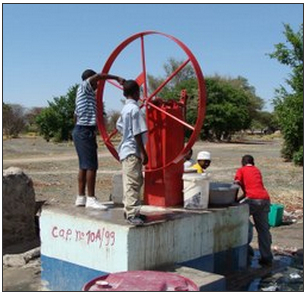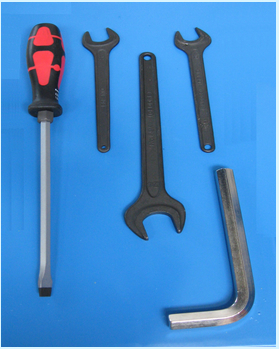Afripump / Blue pump


The Afripump, also called the Blue pump, is an upgrade from the Volanta pump. It no longer has a flywheel, is cheaper, and is said to be more reliable. The Afripump is the upgrade to communities with existing Volanta pumps. Below is the story and details of how the Afripump came to be more useful and some information about the Volanta pump, for those still existing in use.
First came the Volanta pump
The Volanta Pump, created by Jansen Venneboer B.V., is a reciprocating pump driven by a large flywheel for medium to very deep wells. It uses a retractable cylinder and a seal-less stainless steel piston. A crank and a connecting rod convert the rotary motion into a reciprocating action, which is transmitted to the plunger via stainless steel pump rods. The crankshaft and the flywheel run on ball bearings mounted on a plate that can be fixed to a steel or concrete pedestal. The cylinder is of glass fibre reinforced plastic with a close-fitting seal-less stainless steel plunger. The complete cylinder can be lifted from the well by the threaded pump rods, without removing the PVC-U rising main. The stroke is adjustable to reduce the effort needed at deep installations.
It is designed for heavy-duty use and the maximum recommended lift is 70 m.
The Volanta Pump is not in the public domain and information can be asked from the manufacturer. The Volanta Pump is fully corrosion resistant. It is rather difficult to install and it needs extensive masonry work. Maintenance is easy so that communities can care for the pumps.
The BluePump
The BluePump was designed by the FairWater Foundation with the imput of many NGOs in Africa. A major contribution was given by Oxfam Kenya, that has tested the early models of the BluePump in it's handpump rehabilitation project in Turkana, Northern Kenya. After several modifications to addapt the BluePump for depth up to 100m deep, the BluePump is now considered by most international NGOs as the most reliable handpump, especially suited for deep boreholes. One of the special features of the BluePumps is that the PVC rising main can be extended below the cylinder with a so called "Bottom Support System" (BSS). The BSS takes the heavy load of the PVC pipes to avoid that they will break due to the pumping action.
In many parts of Africa the BluePump is also used to replace older handpumps. To make this a simple operation, the base-plate of the BluePump fits directly onto the old base-plate of the Afridev and India Mark pumps.
The key success of the BluePump is its reliablity. This is due to it's simple and strong design and the fact that it basically needs no spare parts for many years. This means that communities have water for a very long time, at a very low price.
For the Operation & Maintemamce (O&M) asepects of the BluePump FairWater recommends a regional approach, in which an Area Mechanic is involved already in the installation phase of the BluePump and gives additional back-up technical support in case needed. Training of the Area Mechanics and spare-parts supply is available with country dealers, whos also have BluePumps in stock.
More info about the BluePump can be obtained by FairWater.
Why the BluePump is more reliable
Most other handpumps fail due to many technical reasons: The most common propblem is worn out seals and broken pipes. Other problems are leaking footvalves and broken rods. With the BluePump most of these problems do not occur due to a better design.
- The stainless steel rods are 12mm diameter and fully threaded,
- The heavy duty strong bearings are maintence free and may last up to 10+ years
- The rising main is from high quality PVC,
- For deep water levels the BluePump has a bottom support system,
- The piston has no rubber seal and is 100 % maintenance free,
- The footvalve has 2 stainess steel balls fpor double security.
The handle is extendable and can have a counter weight to compensate for the extra weight of the water and rods. Therefore pumping remains easy, also for children, even at greated depth.
Suitable conditions
Distribution: Mainly in West African countries.
Some users find it difficult to start the pump. Small children have to stay away from this pump, because the area of the rotating flywheel can be a dangerous playground.
| Piston nominal diameter: | 50.0 mm |
| Approx. discharge (75 watt input): |
at 20 m head: 1.0 m³/hour at 40 m head: 0.5 m³/hour |
| Pumping lift: | 10 - 80 m |
| Population served: | ~ 300 people |
| Households: | 30 - 50 hh |
| Water consumption: | 15 - 20 l/per capita |
| Type of well: | borehole |
Construction, operations and maintenance
Pump stand & flywheel are made of painted Mild Steel, the rising main consists of PVC-U pipes, the cylinder is made of glass fibre reinforced epoxy resin, plunger & the pump rods are of Stainless Steel and the valves of rubber. The pump is corrosion resistant.
The Volanta Pump is a protected product and is not intended for local manufacturing. However, there are countries where pumps are assembled and installed locally.
The installation of the Volanta Pump is rather difficult but does not need any lifting equipment. However, extensive masonry work is required and skilled installation crews are important.
This pump has a good “Community Management Potential”. Simple tools are needed to pull out the pumping element, including pump rod and foot valve. The seal-less piston means that no regular replacement of worn rubber seals is required.
Afripump

Installation of the Afripump is easy and can be done by one technical person and one assistant. The Afripump comes standard with strong 70/80 m PVC rising mains and 9 mm stainless steel rods with threaded connections (Volanta technology). For the installations, no special tools or tripod is required, only keys nr 24 and 17 are needed to complete the installation. When the concrete base and drainage platform is ready, the metal stand is fixed on 4 anchor bolts and the pipes are glued and lowered into the borehole casing up to the desired depth. The handle is fitted to the base with 4 M16 bolts. The cilinder is lowered with the rods and the last rod is attached to the handle. The cover is put on and the pump is ready to use.
Based on the experience with the Volanta handpump, the maintenance of the Afripump is limited to cleaning of the pump and platform, checking and occasionally tightening of some nuts & bolts, maybe applying paint from time to time, all other parts are maintenance free.
The Afripump is also 100 % VLOM (Village Level Operated & Maintained) because the few simple activities can be done by a local caretaker with local available materials and require no special tools, equipment or training.
Costs
Studies show that families in rural communities will agree to pay 1 to 3 US$ per month for a reliable water supply, especially when there are no alternative nearby water sources available. One handpump can serve 25 to 50 families that need 125 to 250 buckets of 20 litres/day, which equals 3 to 6 hours of pumping. This is enough to pay 25 to 50 US$ per month for the supervisor, the remaining revenues are sufficient to pay back the loan fully in 3 to 5 years.
Manuals, videos and links
- Jansen Venneboer: Volanta Pump (in Dutch). Jansen-venneboer.com
- The Volanta Pump. Handpump.org
- Volanta pump. Practica Foundation
- New name for the Afripump: BluePump - BluePump by Fairwater. The main distributor of the BluePump is Boode waterwell systems.
Acknowledgements
- Implementation • Handpump Technology Volanta. RWSN.
- The Afripump. Handpump.org
